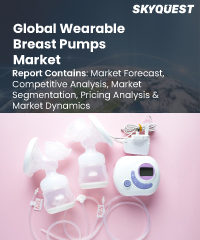USD 478.65 million

Global Wearable Breast Pumps Market Size, Share, Growth Analysis, By Component(Wearable Pumps and Accessories), By Technology(Manual Wearable Breast Pumps, Battery Operated Wearable Breast Pumps) - Industry Forecast 2024-2031
Report ID:
SQMIG35A2356 |
Region:
Global |
Published Date: February, 2024
Pages:
157
|
Tables:
61 |
Figures:
75
Global Wearable Breast Pumps Market Insights
Wearable Breast Pumps Market size was valued at USD 478.65 million in 2021 and is poised to grow from USD 518.76 million in 2022 to USD 1070.31 million by 2030, at a CAGR of 8.38% during the forecast period (2023-2030).
Global Wearable Breast Pumps Market has experienced significant growth and innovation in recent years, revolutionizing the way women approach breastfeeding and breast milk expression. Wearable breast pumps are designed to provide convenience, mobility, and discreetness to lactating mothers, allowing them to express milk anytime and anywhere. One of the key factors driving the growth of the global market is the increasing number of working women who choose to breastfeed their babies. With the rising participation of women in the workforce, there is a growing demand for breast pumps that offer convenience and flexibility, enabling mothers to maintain their breastfeeding goals while managing their professional lives. Advancements in technology have played a significant role in the development of wearable breast pumps. These devices are often powered by rechargeable batteries or are battery-operated, eliminating the need for external power sources. Some models are equipped with smart features, such as mobile apps that allow mothers to track their pumping sessions, monitor milk supply, and customize pumping settings for optimal comfort and efficiency. Furthermore, the growing awareness of the benefits of breastfeeding, such as improved infant health and bonding, has led to an increased adoption of wearable breast pumps. These pumps offer a convenient alternative for mothers who may face challenges with direct breastfeeding, such as latching difficulties or concerns about privacy in public settings. The global Wearable Breast Pumps Market is highly competitive, with several established players and emerging startups introducing innovative products. These companies are focused on improving product design, enhancing user experience, and incorporating advanced technologies to meet the evolving needs of lactating mothers. In conclusion, the global market is witnessing significant growth due to the increasing number of working mothers, technological advancements, and the rising awareness of the benefits of breastfeeding. As the market continues to expand, we can expect further innovation in wearable breast pump technology, providing greater convenience and support to nursing mothers worldwide.
US Wearable Breast Pumps Market is poised to grow at a sustainable CAGR for the next forecast year.
Market snapshot - 2024-2031
Global Market Size
Largest Segment
Wearable Pumps
Fastest Growth
Wearable Pumps
Growth Rate
8.38% CAGR
To get more reports on the above market click here to Buy The Report
Global Wearable Breast Pumps Market Segmental Analysis
Global Wearable Breast Pumps Market is segmented on the basis of component, technology, and region. By component, the market is segmented into Wearable Pumps and Accessories. By technology, the market is segmented into Manual Wearable Breast Pumps, Battery Operated Wearable Breast Pumps, and Smart Wearable Breast Pumps. By region, the market is segmented into North America, Europe, Asia Pacific, Middle East and Africa, and Latin America.
Wearable Breast Pumps Market Analysis By Component
The global Wearable Breast Pumps Market can be segmented based on component types, including Wearable Pumps and Accessories. Wearable pumps are the dominating segment in the global market. These pumps are the core components that directly facilitate milk expression. They are designed to be compact, lightweight, and discreet, allowing mothers to conveniently express milk while performing daily activities or on the go. Wearable pumps offer hands-free operation, customizable settings, and innovative features such as rechargeable batteries and smart controls. The dominating position of wearable pumps can be attributed to the high demand for efficient and convenient breast pump solutions among working mothers, who seek devices that seamlessly integrate into their busy lifestyles. Established market players and emerging companies continuously innovate and improve the design and functionality of wearable pumps, driving their dominance in the global market.
Accessories is the fastest-growing segment in the global Wearable Breast Pumps Market. These accessories complement and enhance the functionality of wearable pumps. Common accessories include breast milk storage bags, extra pumping parts, flanges, tubing, valves, and adapters. The increasing adoption of wearable breast pumps has resulted in a growing demand for related accessories, as users seek to optimize their pumping experience and ensure convenient storage and handling of expressed milk. The accessories segment is experiencing significant growth due to factors such as the need for replacement parts, customization options, and the desire for convenient and hygienic milk storage solutions. Companies in the market are expanding their accessory offerings and introducing innovative products to cater to the evolving needs of breastfeeding mothers, further fueling the growth of this segment.
Wearable Breast Pumps Market Analysis By Technology
Smart Wearable Breast Pumps have emerged as the dominating segment in the global market. These pumps are equipped with advanced technologies and features, such as mobile connectivity, sensors, and customizable settings. They often come with accompanying mobile apps that allow mothers to track pumping sessions, monitor milk supply, and adjust settings for optimal comfort and efficiency. The dominance of this segment can be attributed to the increasing demand for convenient and user-friendly breast pump solutions that align with modern lifestyles. Smart Wearable Breast Pumps offer enhanced convenience, control, and data tracking capabilities, making them popular among tech-savvy mothers seeking a seamless breastfeeding experience.
The Battery Operated Wearable Breast Pumps segment is the fastest-growing segment in the global market. These pumps are designed to be portable and offer hands-free operation, providing mobility and convenience to nursing mothers. Battery-operated pumps eliminate the need for external power sources, enabling mothers to express milk anytime and anywhere. The increasing number of working mothers, along with the rising awareness of the benefits of breastfeeding, is driving the demand for Battery Operated Wearable Breast Pumps. They provide flexibility for on-the-go pumping sessions, allowing mothers to maintain their breastfeeding routines even while engaged in daily activities or away from a power source. The segment is witnessing significant growth due to the combination of convenience, portability, and efficient operation.
To get detailed analysis on other segments, Request For Free Sample Report
Global Wearable Breast Pumps Market Regional Insights
The dominating region in the global Wearable Breast Pumps Market is North America, which holds a market share of 54.2%. This can be attributed to several factors, including the high awareness and acceptance of breastfeeding practices, strong healthcare infrastructure, and supportive government policies in countries like the United States and Canada. Moreover, the increasing number of working mothers and their preference for technologically advanced and convenient breast pump solutions further contribute to the dominance of North America. Established players in the region, along with the presence of innovative startups, drive market growth by offering a wide range of wearable breast pump options with advanced features and user-friendly designs.
Asia Pacific is the fastest-growing region in the global Wearable Breast Pumps Market. The region is experiencing a rapid increase in disposable income, urbanization, and the number of women joining the workforce. These factors, coupled with the growing awareness of the benefits of breastfeeding, are driving the demand for wearable breast pumps. In addition, the cultural shift towards breastfeeding and the rising adoption of modern parenting practices in countries like China, India, and Japan contribute to the growth of the market in Asia Pacific. The presence of a large population base and the rising focus on maternal and child healthcare further fuel market expansion. Market players are increasingly targeting the Asia Pacific region, introducing localized products, and expanding their distribution networks to tap into the significant growth opportunities presented by this region.
- Largest
- Fastest
To know more about the market opportunities by region and country, click here to
Buy The Complete Report
Global Wearable Breast Pumps Market Dynamics
Wearable Breast Pumps Market Drivers
Increasing Growing Demand for On-the-Go Solutions
- There is a growing demand for breast pumps that offer on-the-go capabilities. Wearable breast pumps provide the flexibility and mobility that traditional pumps lack. They allow mothers to express milk discreetly and comfortably while performing daily activities or even during travel, enabling them to maintain their breastfeeding routine irrespective of their location.
Supportive Government Initiatives and Workplace Policies
- Government initiatives and workplace policies that promote breastfeeding and support working mothers have had a positive impact on the market. Several countries have implemented regulations and policies that provide lactation breaks, dedicated breastfeeding areas, and support for breastfeeding mothers. These initiatives have increased the demand for wearable breast pumps as mothers seek tools to facilitate their breastfeeding journey.
Wearable Breast Pumps Market Restraints
Stringent Maintenance and Cleaning
- Wearable breast pumps require regular maintenance and cleaning to ensure hygiene and optimal performance. The additional steps involved in cleaning wearable pumps, compared to traditional pumps, may pose challenges for some users. Busy schedules or lack of proper cleaning facilities can affect the convenience and ease of use, deterring potential users.
Potential Discomfort and Fit Issues
- While wearable breast pumps aim to provide comfort, some users may experience discomfort or fit issues. Each woman's breast shape and size are unique, and finding the right fit can be challenging. Ill-fitting pumps may not provide effective suction or may cause discomfort during usage, affecting user satisfaction and adoption.
Request Free Customization of this report to help us to meet your business objectives.
Global Wearable Breast Pumps Market Competitive Landscape
The global wearable breast pumps market is highly competitive and characterized by the presence of several key players. The competitive landscape of the global market is characterized by intense competition and a mix of established players and emerging companies. Key players in the market have been focusing on innovation, product differentiation, and strategic partnerships to gain a competitive edge. Overall, the competitive landscape of the global market is dynamic, with companies striving to offer unique features, user-centric designs, and enhanced convenience to gain a larger market share. Innovation and technological advancements remain crucial factors driving competition and shaping the future of this market.
Wearable Breast Pumps Market Top Player’s Company Profiles
- Philips Avent (Netherlands)
- Spectra Baby USA (US)
- Freemie (US)
- Lansinoh Laboratories, Inc. (US)
- Ardo Medical AG (Switzerland)
- Haakaa (New Zealand)
- BabyBuddha (US)
- BelleMa (US)
- Naya Health Inc. (US)
- Evenflo Feeding, Inc. (US)
- Ameda AG (Switzerland)
- Baby Brezza (US)
- Pigeon Corporation (Japan)
- Rumble Tuff (US)
- Tommee Tippee (UK)
- Snow Bear (US)
- Mamava (US)
Wearable Breast Pumps Market Recent Developments
- In January 2023, A Willow 3.0 pump companion app for the Apple Watch was released by Willow Innovations, Inc. With a smartwatch companion app, Willow 3.0 offers mothers more control and customization while they pump. Such developments gave the business a competitive advantage.
- In January 2022, In Canada, Medela AG introduced Solo, a lightweight, convenient single electric breast pump. The company's product portfolio and customer base were both improved as a result of this product introduction.
Global Wearable Breast Pumps Key Market Trends
- Increasing Demand for Hands-Free and Portable Solutions: One of the key market trends in the wearable breast pumps industry is the growing demand for hands-free and portable solutions. Lactating mothers are seeking pumps that allow them to express milk conveniently while performing daily activities or even while on the go. Wearable pumps provide the freedom and mobility that traditional pumps lack.
- Technological Advancements and Smart Features: The market is witnessing significant advancements in technology, with wearable breast pumps incorporating smart features. These features include mobile apps for tracking pumping sessions, monitoring milk supply, and customizing pumping settings. Technological innovations aim to enhance user experience, convenience, and efficiency.
Global Wearable Breast Pumps Market SkyQuest Analysis
SkyQuest’s ABIRAW (Advanced Business Intelligence, Research & Analysis Wing) is our Business Information Services team that Collects, Collates, Correlates, and Analyzes the Data collected by means of Primary Exploratory Research backed by robust Secondary Desk research.
According to our global Wearable Breast Pumps Market analysis, the market has experienced remarkable growth, offering a convenient and portable solution for breastfeeding mothers.. Technological advancements have played a crucial role, with pumps powered by rechargeable batteries and equipped with smart features like mobile apps for tracking and customization. The growing awareness of breastfeeding benefits, such as improved infant health and bonding, has also contributed to market expansion. Wearable breast pumps offer a convenient alternative for mothers facing challenges with direct breastfeeding. The market is highly competitive, with established players and startups focusing on product design and incorporating advanced technologies. The market is expected to witness further innovation as companies strive to enhance user experience and meet the evolving demands of lactating women worldwide.
| Report Metric | Details |
|---|---|
| Market size value in 2023 | USD 478.65 million |
| Market size value in 2031 | USD 1070.31 million |
| Growth Rate | 8.38% |
| Forecast period | 2024-2031 |
| Forecast Unit (Value) | USD Million |
| Segments covered |
|
| Regions covered | North America (US, Canada), Europe (Germany, France, United Kingdom, Italy, Spain, Rest of Europe), Asia Pacific (China, India, Japan, Rest of Asia-Pacific), Latin America (Brazil, Rest of Latin America), Middle East & Africa (South Africa, GCC Countries, Rest of MEA) |
| Companies covered |
|
| Customization scope | Free report customization with purchase. Customization includes:-
|
To get a free trial access to our platform which is a one stop solution for all your data requirements for quicker decision making. This platform allows you to compare markets, competitors who are prominent in the market, and mega trends that are influencing the dynamics in the market. Also, get access to detailed SkyQuest exclusive matrix.
Buy The Complete Report to read the analyzed strategies adopted by the top vendors either to retain or gain market share
Table Of Content
Executive Summary
Market overview
- Exhibit: Executive Summary – Chart on Market Overview
- Exhibit: Executive Summary – Data Table on Market Overview
- Exhibit: Executive Summary – Chart on Global Wearable Breast Pumps Market Characteristics
- Exhibit: Executive Summary – Chart on Market by Geography
- Exhibit: Executive Summary – Chart on Market Segmentation
- Exhibit: Executive Summary – Chart on Incremental Growth
- Exhibit: Executive Summary – Data Table on Incremental Growth
- Exhibit: Executive Summary – Chart on Vendor Market Positioning
Parent Market Analysis
Market overview
Market size
- Market Dynamics
- Exhibit: Impact analysis of DROC, 2021
- Drivers
- Opportunities
- Restraints
- Challenges
- Exhibit: Impact analysis of DROC, 2021
- SWOT Analysis
KEY MARKET INSIGHTS
- Technology Analysis
- (Exhibit: Data Table: Name of technology and details)
- Pricing Analysis
- (Exhibit: Data Table: Name of technology and pricing details)
- Supply Chain Analysis
- (Exhibit: Detailed Supply Chain Presentation)
- Value Chain Analysis
- (Exhibit: Detailed Value Chain Presentation)
- Ecosystem Of the Market
- Exhibit: Parent Market Ecosystem Market Analysis
- Exhibit: Market Characteristics of Parent Market
- IP Analysis
- (Exhibit: Data Table: Name of product/technology, patents filed, inventor/company name, acquiring firm)
- Trade Analysis
- (Exhibit: Data Table: Import and Export data details)
- Startup Analysis
- (Exhibit: Data Table: Emerging startups details)
- Raw Material Analysis
- (Exhibit: Data Table: Mapping of key raw materials)
- Innovation Matrix
- (Exhibit: Positioning Matrix: Mapping of new and existing technologies)
- Pipeline product Analysis
- (Exhibit: Data Table: Name of companies and pipeline products, regional mapping)
- Macroeconomic Indicators
COVID IMPACT
- Introduction
- Impact On Economy—scenario Assessment
- Exhibit: Data on GDP - Year-over-year growth 2016-2022 (%)
- Revised Market Size
- Exhibit: Data Table on Global Wearable Breast Pumps Market size and forecast 2021-2027 ($ million)
- Impact Of COVID On Key Segments
- Exhibit: Data Table on Segment Market size and forecast 2021-2027 ($ million)
- COVID Strategies By Company
- Exhibit: Analysis on key strategies adopted by companies
MARKET DYNAMICS & OUTLOOK
- Market Dynamics
- Exhibit: Impact analysis of DROC, 2021
- Drivers
- Opportunities
- Restraints
- Challenges
- Exhibit: Impact analysis of DROC, 2021
- Regulatory Landscape
- Exhibit: Data Table on regulation from different region
- SWOT Analysis
- Porters Analysis
- Competitive rivalry
- Exhibit: Competitive rivalry Impact of key factors, 2021
- Threat of substitute products
- Exhibit: Threat of Substitute Products Impact of key factors, 2021
- Bargaining power of buyers
- Exhibit: buyers bargaining power Impact of key factors, 2021
- Threat of new entrants
- Exhibit: Threat of new entrants Impact of key factors, 2021
- Bargaining power of suppliers
- Exhibit: Threat of suppliers bargaining power Impact of key factors, 2021
- Competitive rivalry
- Skyquest special insights on future disruptions
- Political Impact
- Economic impact
- Social Impact
- Technical Impact
- Environmental Impact
- Legal Impact
Market Size by Region
- Chart on Market share by geography 2021-2027 (%)
- Data Table on Market share by geography 2021-2027(%)
- North America
- Chart on Market share by country 2021-2027 (%)
- Data Table on Market share by country 2021-2027(%)
- USA
- Exhibit: Chart on Market share 2021-2027 (%)
- Exhibit: Market size and forecast 2021-2027 ($ million)
- Canada
- Exhibit: Chart on Market share 2021-2027 (%)
- Exhibit: Market size and forecast 2021-2027 ($ million)
- Europe
- Chart on Market share by country 2021-2027 (%)
- Data Table on Market share by country 2021-2027(%)
- Germany
- Exhibit: Chart on Market share 2021-2027 (%)
- Exhibit: Market size and forecast 2021-2027 ($ million)
- Spain
- Exhibit: Chart on Market share 2021-2027 (%)
- Exhibit: Market size and forecast 2021-2027 ($ million)
- France
- Exhibit: Chart on Market share 2021-2027 (%)
- Exhibit: Market size and forecast 2021-2027 ($ million)
- UK
- Exhibit: Chart on Market share 2021-2027 (%)
- Exhibit: Market size and forecast 2021-2027 ($ million)
- Rest of Europe
- Exhibit: Chart on Market share 2021-2027 (%)
- Exhibit: Market size and forecast 2021-2027 ($ million)
- Asia Pacific
- Chart on Market share by country 2021-2027 (%)
- Data Table on Market share by country 2021-2027(%)
- China
- Exhibit: Chart on Market share 2021-2027 (%)
- Exhibit: Market size and forecast 2021-2027 ($ million)
- India
- Exhibit: Chart on Market share 2021-2027 (%)
- Exhibit: Market size and forecast 2021-2027 ($ million)
- Japan
- Exhibit: Chart on Market share 2021-2027 (%)
- Exhibit: Market size and forecast 2021-2027 ($ million)
- South Korea
- Exhibit: Chart on Market share 2021-2027 (%)
- Exhibit: Market size and forecast 2021-2027 ($ million)
- Rest of Asia Pacific
- Exhibit: Chart on Market share 2021-2027 (%)
- Exhibit: Market size and forecast 2021-2027 ($ million)
- Latin America
- Chart on Market share by country 2021-2027 (%)
- Data Table on Market share by country 2021-2027(%)
- Brazil
- Exhibit: Chart on Market share 2021-2027 (%)
- Exhibit: Market size and forecast 2021-2027 ($ million)
- Rest of South America
- Exhibit: Chart on Market share 2021-2027 (%)
- Exhibit: Market size and forecast 2021-2027 ($ million)
- Middle East & Africa (MEA)
- Chart on Market share by country 2021-2027 (%)
- Data Table on Market share by country 2021-2027(%)
- GCC Countries
- Exhibit: Chart on Market share 2021-2027 (%)
- Exhibit: Market size and forecast 2021-2027 ($ million)
- South Africa
- Exhibit: Chart on Market share 2021-2027 (%)
- Exhibit: Market size and forecast 2021-2027 ($ million)
- Rest of MEA
- Exhibit: Chart on Market share 2021-2027 (%)
- Exhibit: Market size and forecast 2021-2027 ($ million)
KEY COMPANY PROFILES
- Competitive Landscape
- Total number of companies covered
- Exhibit: companies covered in the report, 2021
- Top companies market positioning
- Exhibit: company positioning matrix, 2021
- Top companies market Share
- Exhibit: Pie chart analysis on company market share, 2021(%)
- Total number of companies covered
Methodology
For the Global Wearable Breast Pumps Market, our research methodology involved a mixture of primary and secondary data sources. Key steps involved in the research process are listed below:
1. Information Procurement: This stage involved the procurement of Market data or related information via primary and secondary sources. The various secondary sources used included various company websites, annual reports, trade databases, and paid databases such as Hoover's, Bloomberg Business, Factiva, and Avention. Our team did 45 primary interactions Globally which included several stakeholders such as manufacturers, customers, key opinion leaders, etc. Overall, information procurement was one of the most extensive stages in our research process.
2. Information Analysis: This step involved triangulation of data through bottom-up and top-down approaches to estimate and validate the total size and future estimate of the Global Wearable Breast Pumps Market.
3. Report Formulation: The final step entailed the placement of data points in appropriate Market spaces in an attempt to deduce viable conclusions.
4. Validation & Publishing: Validation is the most important step in the process. Validation & re-validation via an intricately designed process helped us finalize data points to be used for final calculations. The final Market estimates and forecasts were then aligned and sent to our panel of industry experts for validation of data. Once the validation was done the report was sent to our Quality Assurance team to ensure adherence to style guides, consistency & design.
Analyst Support
Customization Options
With the given market data, our dedicated team of analysts can offer you the following customization options are available for the Global Wearable Breast Pumps Market:
Product Analysis: Product matrix, which offers a detailed comparison of the product portfolio of companies.
Regional Analysis: Further analysis of the Global Wearable Breast Pumps Market for additional countries.
Competitive Analysis: Detailed analysis and profiling of additional Market players & comparative analysis of competitive products.
Go to Market Strategy: Find the high-growth channels to invest your marketing efforts and increase your customer base.
Innovation Mapping: Identify racial solutions and innovation, connected to deep ecosystems of innovators, start-ups, academics, and strategic partners.
Category Intelligence: Customized intelligence that is relevant to their supply Markets will enable them to make smarter sourcing decisions and improve their category management.
Public Company Transcript Analysis: To improve the investment performance by generating new alpha and making better-informed decisions.
Social Media Listening: To analyze the conversations and trends happening not just around your brand, but around your industry as a whole, and use those insights to make better Marketing decisions.
Global Wearable Breast Pumps Market Report Snapshots
Want to customize this report?
Our industry expert will work with you to provide you with customized data in a short amount of time.
REQUEST FREE CUSTOMIZATION



 USA (+1) 351-333-4748
USA (+1) 351-333-4748
